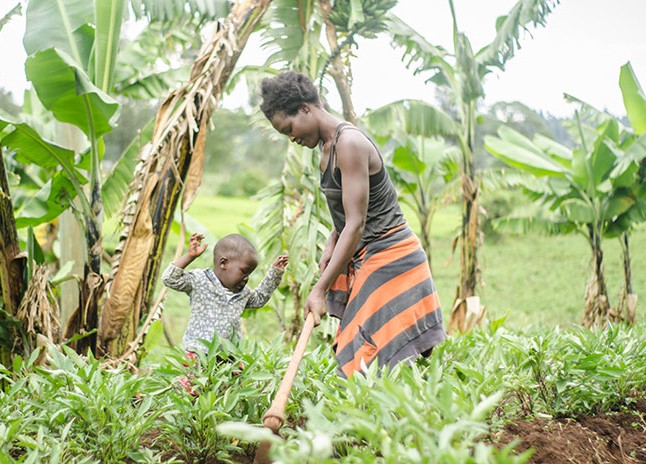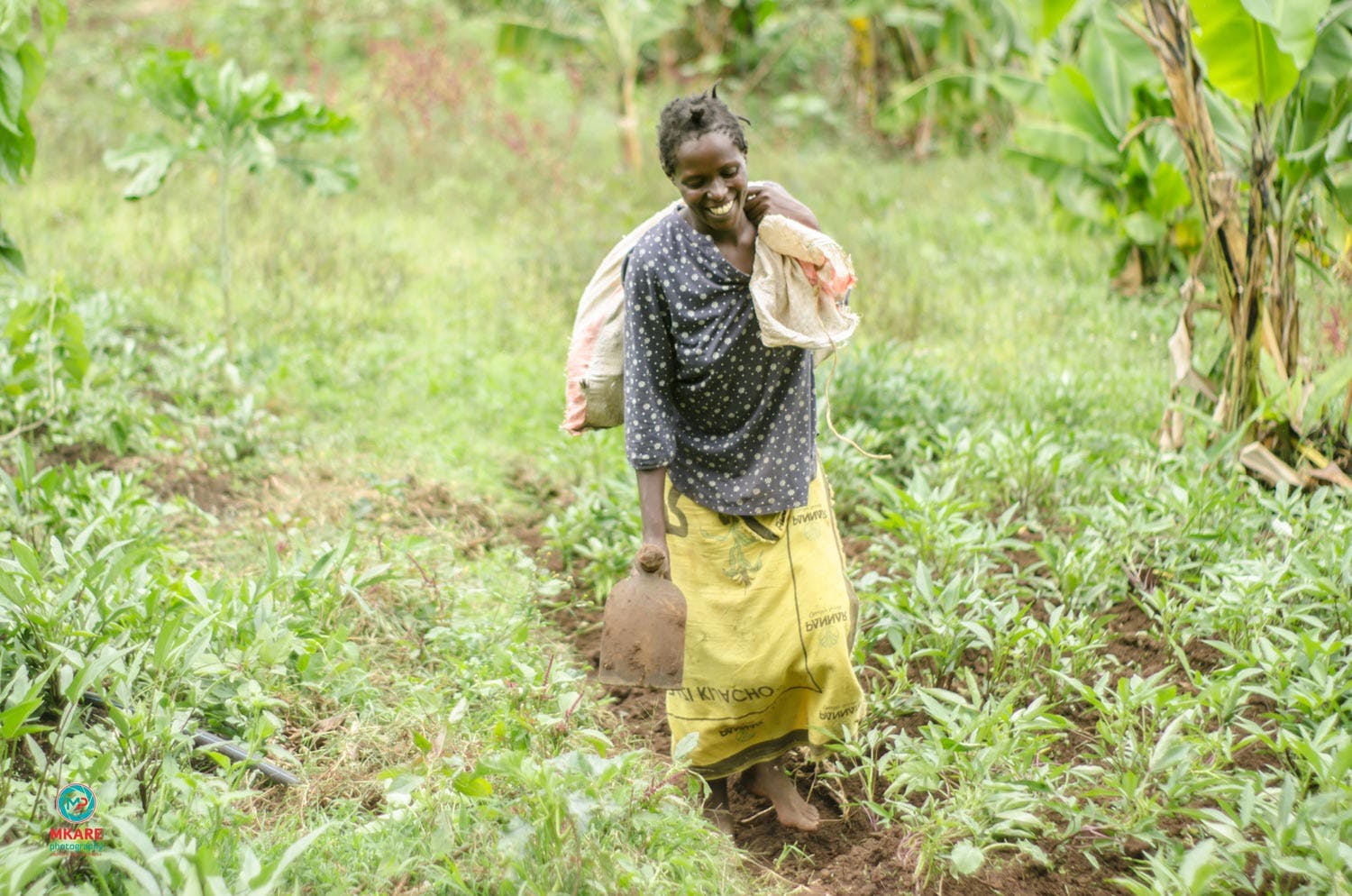Kisumu’s Climate-Smart Farmers
Kenya’s smallholder farmers are adapting to a new climate reality.
Ester Chebet is a farmer in the Kisumu region of Kenya.
In Nyalenda Village, Kisumu County, Kenya, Millicent Odera grows maize (what North Americans call “corn”), beans, leafy vegetables, butternut squash, pumpkins, and onions on 1 hectare of land. She’s been at it for 20 years. But, six years into her small agribusiness, she noticed the productivity of her farm dwindling.
“I used to harvest up to 20 sacks of maize, when I started, which reduced to just eight over time,” recalls Odera. Continuous application of synthetic fertilizers and pesticides had depleted soil nutrients. Meanwhile, shifting rainfall patterns had dented the ability of farmers to accurately predict planting seasons. Increased floods and droughts due to climate change often resulted in farm losses due to death of crops. As a response, Odera moved away from conventional farming methods and tools, including pesticides, synthetic fertilizers, and slash-and-burn agriculture.
She’s among a group of smallholder farmers across Kenya who are reacting to environmental changes spurred by climate change by adopting new techniques to sustain their livelihoods, often with environmental benefits. These farmers are shifting away from traditional rain-fed agriculture by employing irrigation, using compost manure to add nutrients and minimize dependence on synthetic fertilizers, and growing crops that mature more quickly and require less rainfall.
In most areas, farmers are battling with more clear signs of climate change.
The farmers also learn about drought-tolerant species, proper seed storage, tree selection for agroforestry, and water management from government agricultural extension personnel. Some are also taking up poultry farming instead of rearing livestock, motivated by the smaller amount of water, feed, and land required by birds.
The impact of such changes can be significant. A 2020 study published in World Development Perspectives found that uptake of stress-tolerant crops in Kenya’s Nyando basin improved household income by 83%. Even so, many farmers struggle to improve productivity, with many lacking knowledge of how to confront the rising challenges posed by climate change.
In the quest to improve her farm, Odero began rearing chickens, practicing vertical gardening, and growing vegetables in vessels that could retain moisture during dry seasons. She also undertook rainwater harvesting and storage to irrigate her vegetable garden during dry seasons and planted fruit trees, which provide mulching materials, additional food, and fuel wood.
“Changing climatic conditions forced me to shift from traditional to modern farming methods,” says Odero. The changes also cut back on her farm’s carbon emissions, she adds.
Unpredictable patterns
Across Kenya, smallholder farmers — who produce over 70% of the country’s food and largely rely on rainfed agriculture — are contending with the impacts of climate change. Rainfall and sun patterns are becoming harder to predict, and droughts and floods are becoming more extreme. Since early 2020, the country has been coping with what is said to be the worst desert locust invasion in 70 years. Induced by heavy and widespread rainfall in East Africa, swarms of locusts have devastated entire fields. Climate change will continue to adversely affect Kenyan food security, with a decline in yields of up to 69% by the year 2100, according to a 2016 paper published by Environment for Development, a global network of research centres.
“In most areas, farmers are battling with what seems to be more clear signs of climate change,” says Esther Maina, an associate environmental consultant at Lead Securities Limited, a consultancy that undertakes environmental and social impact assessments of farming ventures in Kenya. “And this could have more grave impacts on our overall food security if innovative approaches are not quickly adopted.”
Cultivating soils
Milicent Akoth, another smallholder farmer from Kisumu County, says she believes the secret to climate-smart farming lies in healthy soils. Starting in 2004, Akoth recorded dwindling yields — a challenge she attributes to poor soil nutrient and moisture balance.
“In 2010, I sought the services of an agricultural extension officer from whom I learnt that besides poor moisture retention, my soil was highly acidic. This meant the soils could not support many of the crop varieties that we grow in this region,” she says. Akoth began using organic manure to reduce soil acidity, and introduced crops — such as sweet potatoes and chilis — that perform well in acidic soil.

Doreen Cherono farms in Kisumu.
“With proper soil management, you do not need huge tracts of land,” says Akoth. Through proceeds from the farm, she can comfortably feed her family with a variety of fresh nutritious foods including sweet potatoes, peas, leafy vegetables, maize, cabbages, onions, and tomatoes.
Akoth uses part of the farm as a demonstration plot to train other women on soil and farm water management techniques. “I am confident that when this knowledge is passed on — especially to women who are the key custodians of our diets — the region will be food-sufficient,” she says.
Her trainings help fill a dire gap. Even though smallholder farmers grow most of Kenya’s fruits and vegetables, they lack information about emerging climate challenges and how to respond to them.
Conserving resources
In Nyalenda B Village, Kisumu County, about a hundred chickens cluck around Abigael Malanda’s 1,000 square metre farm. Malanda used to keep cattle, but due to climate change and the resultant dwindling water supply, she found it hard to maintain a sizable herd that could guarantee good returns.
In 2010, she shifted to poultry-keeping, after training herself online to raise chickens. Birds generally require smaller spaces and consume less water and feed compared to livestock, and raising them results in fewer carbon emissions, she says. She also maintains an egg incubation unit and 20 ornamental birds on her farm.
When this knowledge is passed on, the region will be food-sufficient.
Malanda says she keeps her farm’s ecological footprint low by keeping the flock number small and sourcing almost all of her inputs locally. She also enjoys a ready market, since poultry farming is not widespread in the area. “Most of our customers collect their orders for eggs, meat, and live birds directly from the farm,” she says.
She’s keen to share her knowledge and help others conserve resources. Since 2018, Malanda has taught poultry husbandry to over 500 farmers from the area with a focus on helping other women.
She tells them about the economic and environmental benefits of raising poultry, she says. “I find happiness in seeing other women improve their income and mitigate climate change.”
Print Issue: Spring/Summer 2021
